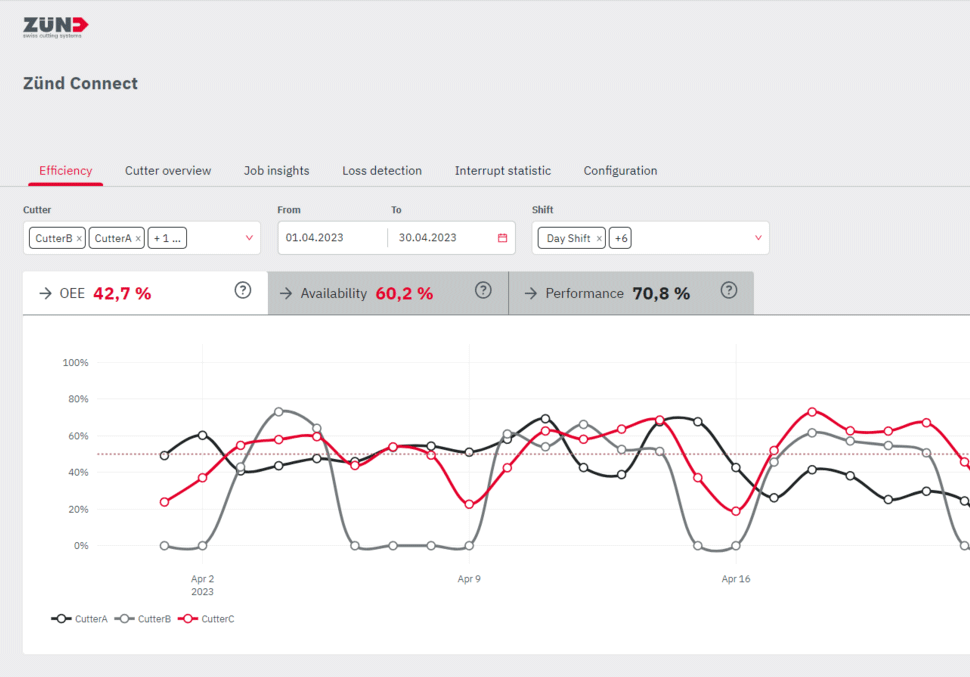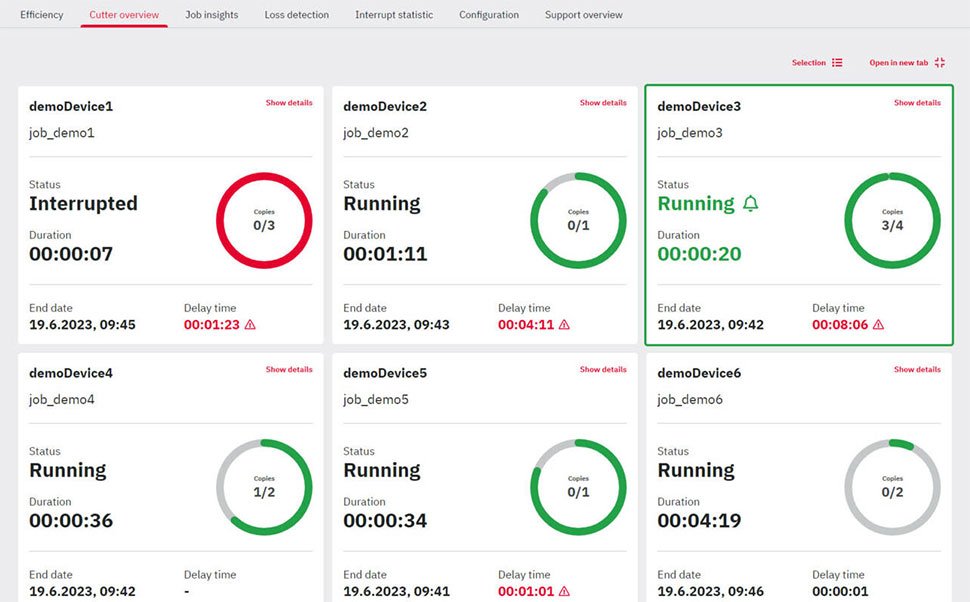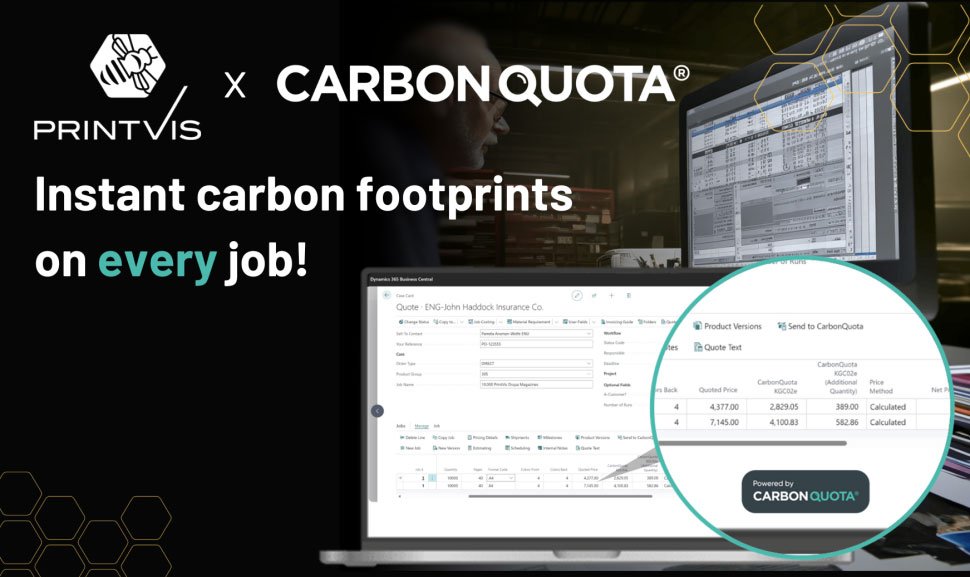While perhaps not one of the “sexier” topics, there is no overstating the importance of software to the modern print business. Be it management information systems for ensuring production is running effectively or colour management software to help achieve accuracy, under-investment here could see you fall behind the competition.
Of course, identifying and investing in the right product is only half the battle; it is how you then use this software that can have a significant impact on your business. Like when you buy a new printer, if you haven’t got the setup quite right or aren’t taking advantage of its full range of capabilities, you will not feel the full benefit.
With this in mind, we spoke with several leading providers of workflow software to find out more about these solutions, including how greater monitoring or analysis of the data this software produces can shed more light on production and allow you to implement changes that will strengthen your services in the long run.
Lending a hand
In previous years, print companies needed to approach specialist software providers for solutions in this area. However, over time, hardware manufacturers have cottoned on to the fact that they too can deliver software to their customers and offer an ‘all-in-one’ solution.
HP is one of the industry’s leading brands to do exactly this. Luke Harriss, NWE Marketing Manager for Large-Format Printing at HP, said knowing what is happening in the print room is crucial to any print business – and data analysis will allow printers to learn more about production.
“By closely watching workflow data, printers can find bottlenecks and inefficiencies in their processes. This allows them to streamline operations, reduce downtime, and improve overall productivity,” Luke said. “Workflow data also helps in tracking resource usage, such as ink and paper, and showing areas where waste can be reduced. Detailed workflow data offers valuable insights that can inform strategic decisions, such as when to upgrade equipment or adjust staffing levels.
“By using workflow data, printers can not only improve their current operations but also position themselves for future growth and adaptability in a competitive market.”
Efficient workflows and high-quality outputs, Luke added, lead to faster delivery times and more reliable services, which in turn helps to enhance customer satisfaction and loyalty. He said that a well-implemented monitoring system can easily adapt to growing business needs, thus supporting scalability and future growth.
“By investing in a quality setup for monitoring workflow data, businesses can then help promote greater operational efficiency, cost-effectiveness, and customer satisfaction,” Luke said.
On this, Luke draws attention to several options from HP. These include HP Site Flow Print production workflow, which optimises operational productivity and results. Not so long ago, HP published a white paper on the benefits of this system and how it can be used to overhaul how a print business runs.

Also from HP is HP PrintOS, a cloud-based print production operating system designed to help print companies – especially those in the large-format sector – improve their operation. PrintOS allows users to check and manage their print operations from virtually anywhere, using the web and mobile apps, meaning they can constantly keep track of and monitor performance.
“The platform provides real-time and historical data insights to help improve print operations, show bottlenecks, and enhance productivity,” Luke said. “With tools like Print Beat, users can track printer performance and make data-driven decisions.
“The system includes features like Substrate Manager and Media Locator to centrally manage and improve the use of printing materials. There is also an especially useful Learn with HP which has many courses for the print room operators to improve their skills or to train new staff on how to run and maintain their printers.
“Overall, HP PrintOS helps printers streamline their workflows, reduce costs, and improve the quality and efficiency of their print production.”
Work smart, not hard
Also offering insight is Rob Goleniowski, Head of Sales for the UK and Ireland at Roland DG UK, which, like HP, provides software solutions alongside its hardware. Rob said when it comes to using software, it is very much a case of work smarter, not harder.
“Using resources efficiently is an important part of any success, and this includes printers,” Rob said. “Software is important here to help with things like minimising the time taken to get a file from a customer and on to the printer, maximising the usage of the materials and inks, but then other things like being produced to make finishing and fitting easier as well. The workflow is important to ensure that the operators get the maximum time to do the tasks that add value and leave the equipment to do its job.”
Leading on from this, Rob said the core benefits of quality workflow software are reduce costs, more capacity, lower turnaround times and less wastage, all of which are the result of an efficient set up that allows for optimal production.
“Add in the reduced pressure on staff to complete jobs within the deadlines and there are lots of wins,” Rob added.”
As for what Roland has on offer, Rob picks out Roland VersaWorks 6 RIP and DG Connect. Starting with VersaWorks, he says this has many options for the user. Good examples of workflow data and efficiency include the multiple print queues that allow settings to be pre-configured before files are added to reduce set up time.
“Couple this with hot folders which can automatically push print files into the queues and then start printing automatically, and there are very few steps the operator needs to take to get a file printing,” he said.

Looking to DG Connect, Rob bills this as the “shining star of data” in the Roland DG software suite in terms of workflow and connectivity. It allows for the monitoring of Roland printers remotely with information such as a health check, printer usage, ink consumption and updates, as well as offering the facilities to manage and route print files for such instances as jig production.
“If for example a customer has a website where orders are placed for a product, like a pen or phone case, DG Connect can route the file to the correct jig, auto-populate it with the required number of copies and size the artwork so the operator can just bring the ready to go print job into VersaWorks for output,” Rob said.
“This is a huge time saver and greatly helps with the efficiencies. It’s worth pointing out that data is useful in other occasions as well and people can’t overlook that printers are like cars in that they have bits on them that over time will wear out.
“DG Connect can allow the Roland team to view the health of the printer and potentially see when parts are causing issues to help with fault diagnosis and repairs. This reduces downtime and ensures the printers minimise the times when they can’t produce work.”
Reduce potential losses
Another manufacturer that develops software to support its hardware is Zünd. Manuel Zoller, Head of Products Services at Zünd, said data monitoring, particularly in digital cutting, can offer several advantages.
“Firstly, it allows users to recalculate their jobs, which also helps them to provide more accurate quotes,” Manuel said. “Secondly, it allows users to seamlessly monitor their production and identify and reduce potential losses.
“A high-quality setup ensures production data can be processed seamlessly by optimally adapting the customer environment to the requirements. This means that the flow of data is not blocked, allowing production to run smoothly. It also eliminates the need for centralised data storage and the associated risks.
“Most importantly, tedious manual data analysis is eliminated, saving time and resources and significantly increasing efficiency.”

On this, Manuel draws attention to Zünd Connect, a web-based monitoring tool that helps users to recognise potential areas for optimising their digital cutting process. Zünd Connect compiles production data from integrated cutting systems into meaningful key performance indicators, such as cutter capacity, availability, and overall equipment efficiency, with customers then able to use this to analyse their production and highlight areas for improvement.
Zünd Connect gives users access to relevant key figures on factors such as capacity, availability and overall equipment effectiveness. These key performance indicators, Zünd said, provide transparency and pinpoint potential for optimisation in production workflow, with data on downtimes, machine capacity and causes of interruptions all conveniently displayed on the dashboard
“High machine availability and productivity are essential for profitable digital cutting,” Zünd said. “Zünd Connect provides cutter performance data at a glance, at all times. With Zünd Connect, you have access to reliable key performance indicators you can use to make your production workflow even more productive.”
Zünd Connect is available in ‘Monitor’ and ‘Analyzer’ versions, both of which are compatible with the cutter software up to ZCC Version 3.5.x. The Monitor version consists of a graphic display of Overall Equipment Efficiency and is available for free for all ZCC users. Meanwhile, Analyzer provides users with tools to analyse production data and identify the source of losses, allowing for deeper analysis of the cutting workflow to develop recommendations for improvements.

Deliver consistent quality
Of course, print companies still have the option to work with specialist software providers whose core focus is to develop software solutions that can be used with a range of hardware. While this may not be as focused on specific machines as software from the actual manufacturer, it offers an effective solution and, arguably, could be more flexible if you are running machines from several brands.
Within this segment is PrintFactory, a cloud-based printing software ecosystem that encompasses desktop, cloud and mobile apps and tools. Debra Hobden, Global Marketing Director, at PrintFactory says that monitoring workflow data is crucial for printers of all sizes because it provides actionable insights that lead to improved efficiency, cost savings, and better decision-making.
“By understanding how resources like ink, media, and time are utilised, print service providers (PSPs) can identify bottlenecks, optimise production, and deliver consistent quality, all of which help contribute to greater customer satisfaction and profitability,” Debra said.
Core benefits of a quality workflow setup, Debra said, include increased efficiency, with a well-designed workflow monitoring system providing real-time data on production performance, enabling printers to identify inefficiencies and optimise operations.
“The most advanced systems go beyond historical data, offering insights into upcoming production tasks,” she said. “This proactive approach empowers you to make informed decisions and address potential problems or bottlenecks before they impact your workflow.”
Other benefits noted by Debra include costs savings, with accurate data on ink usage, media waste, and machine downtime enabling printers to make more informed decisions, reducing unnecessary expenses and maximising ROI.
On top of this, PSPs can enjoy consistent quality through monitoring colour accuracy and device performance which ensures uniform output across all jobs, while analysing equipment data means printers can anticipate maintenance needs and calibration settings, thus minimising downtime and costly disruptions. In addition, Debra said workflow insights from data gathering provide a foundation for scaling operations effectively while maintaining control over production variables.
“PrintFactory offers an all-in-one solution that simplifies workflow data monitoring and drives results,” she said. “Our cloud-based dashboard allows users to access real-time production metrics from anywhere, providing complete visibility into every job, device, and resource. They gain insight into jobs queued for production and receive health checks to identify potential issues before they arise. This proactive approach enables you to make informed decisions, prevent bottlenecks, and ensure deadlines are met with confidence.”
Other features of PrintFactory include colour consistency across all printers and cutters, regardless of brand or location, reducing reprints and customer complaints. It also offers insight into ink and media usage, saving up to 30% on ink and 50% on media waste, with its intelligent tools.
“Designed for businesses of any size, PrintFactory’s solutions are easy to implement and grow with your needs, and the affordable SaaS (software as a service) plans ensure that they are accessible to any size business without the need for upfront capital investment,” Debra said. “By adopting PrintFactory’s workflow solutions, printers can achieve smarter production, greater profitability, and a competitive edge in today’s demanding market.”
Productivity and profitability

Sebastien Hanssens, Vice President of Marketing and Operations at Caldera, continues the theme of having a competitive edge over other companies. Having a quality system in place and ensuring you make the most out of the data it offers will help printers more effectively manage costs and make a profit, Sebastien said.
“Printers definitely should be measuring the data that they have been collecting about jobs, media consumption, ink consumption and machine uptime,” Sebastien said. “The market and technologies now give printers the opportunity to track data and measure productivity and profitability. While workflow can mean different things to different companies, most commonly it is job tracking and production cost tracking.”
So, how can Caldera help? Sebastien said Caldera RIP solutions include built-in features that track ink and media consumption as well as jobs. Caldera has also launched a new solution called PrimeCenter which is a prepress software that simplifies file preparation for large format printing and cutting.
“Located upstream of the workflow, PrimeCenter checks, corrects, sorts, groups and prepares files for production to save PSPs time preparing jobs and media wastage. It can be used with all industry RIPs that support PDF formats,” Sebastien said.
“Print companies can use PrimeCenter for large-format signage, graphics, sportswear, direct-to-film, packaging, and more.”
Essential for efficiency
Also weighing in is Matt Crawford, President and CEO of Onyx Graphics, which provides RIP, print workflow and business software tools to the wide-format print industry. Matt said that monitoring workflow data should be seen as “essential” for printers of all sizes to maximise efficiency, maintain quality, and stay competitive.
He picks out five core benefits of putting a quality system in place for leveraging workflow data in print, touching on some of the points picked out by others in this piece. Namely, these include enhanced operational efficiency through streamlined processes, resource optimisation and automation.
Matt also says precise job estimations from workflow systems will enable PSPs to improve costs, as well as reduce waste through greater accuracy when planning and carrying out work. On top of this, colour accuracy validation will enhance quality assurance and help prevent errors. He added that data analysed from workflow systems will aid decision making, which in turn will allow print service providers to deliver an overall better service to their customers.
“By leveraging data with a quality system, printers create a foundation for sustainable growth, operational excellence, and superior customer experiences,” Matt said.
Leading on from this, he highlights some of the options available from Onyx. These include ONYX Thrive, ONYX HUB, ONYX Sync, and ONYX ColorCheck, all of which he said provide printers with tools to harness the full potential of their data.
“ONYX HUB acts as a centralised dashboard, displaying real-time workflow data, from ink and media usage to production timelines,” he said. “It enables operators and managers to make informed decisions quickly, optimising resources and identifying inefficiencies. For small print shops, this means better job tracking and streamlined operations. For larger facilities, ONYX HUB ensures consistency and eliminates bottlenecks across high-volume production.
“Through ONYX Sync, our powerful API connection, customers can integrate workflow data directly with their internal systems. This connectivity allows businesses to consolidate reporting, improve job cost estimation, and automate repetitive tasks, saving time while enhancing operational accuracy.
Accurate estimations rely on precise calculations of ink and media usage—capabilities built into our software.
“Additionally, ONYX ColorCheck ensures colour accuracy across jobs, giving customers confidence in delivering consistent, high-quality results.”
Keep a sustainable edge
Of course, performance data is just part of the equation, with wider analysis of data helping to open printers’ eyes to other insights. Cloud-based business management platform PrintVis recently linked up with CarbonQuota to integrate automated carbon footprint calculations into its management solution. This integration enables businesses to track and measure their environmental impact at the same time as managing their day-to-day operations within the PrintVis platform.
PrintVis CEO Kasper Tomshoej talked up the new partnership, saying it has “never been more crucial” to track and calculate carbon data to analyse, reduce, and track carbon emissions.
“This integration offers a unique opportunity for our customers to easily calculate carbon emissions on each order, empowering them to make data-driven sustainability decisions,” Tomshoej said. “CarbonQuota’s expertise in the print industry, combined with our powerful solutions, makes this partnership a game changer for our customers looking to reduce their environmental impact.”
CarbonQuota co-founder Dom Harris also spoke of the transformative potential of the integration, saying tracking and calculating carbon data is now essential to managing and reducing emissions.
“The integration of PrintVis with CarbonQuota’s carbon calculator provides a seamless way for their customers to calculate emissions for every order, equipping them to make informed, sustainable choices,” he said. “CarbonQuota’s deep knowledge of the print industry, paired with robust tools, makes this partnership transformative for customers aiming to lessen their environmental footprint.”

From speaking with those in the know, the message is clear: data analysis can be incredibly helpful for print service providers. While this may not sound like the most interesting of tasks, closer analysis of workflow data can help PSPs identify areas for improvements and open their eyes to what they need to do to deliver a better service to customers. You should certainly consider speaking with your software partners to see how you can strengthen your offering.




